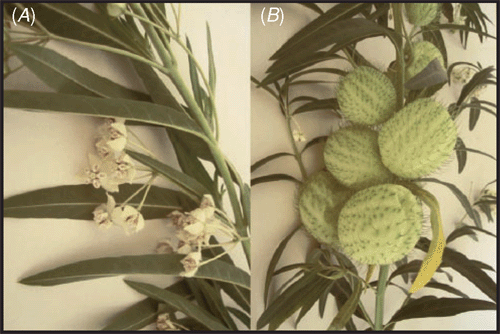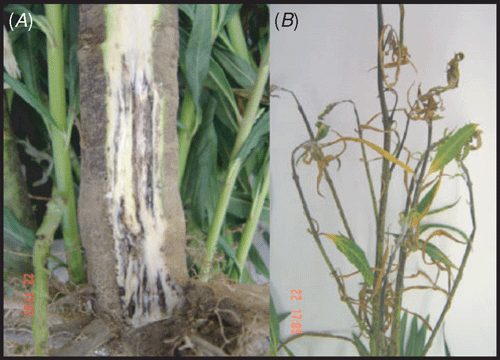First report of Lasiodiplodia theobromae on Asclepias physocarpa in Brazil
I. H. Fischer A C , A. M. Almeida A , M. J. M. Garcia A , R. M. A. Bertani A and C. J. Bueno BA Agência Paulista de Tecnologia dos Agronegócios (APTA), Pólo Regional de Desenvolvimento Tecnológico dos Agronegócios (PRDTA) do Centro Oeste – Unidade de Pesquisa e Desenvolvimento (UPD) de Bauru. Avenue Rodrigues Alves, 40-40, Bauru, São Paulo State 17030-000, Brazil.
B APTA/Instituto Biológico – Centro Experimental Central de Campinas, Highway Heitor Penteado, Kilometers 03, PO Box 70, Campinas, São Paulo State 13001-970, Brazil.
C Corresponding author. Email: ihfische@apta.sp.gov.br
Australasian Plant Disease Notes 3(1) 116-117 https://doi.org/10.1071/DN08046
Submitted: 4 April 2008 Accepted: 31 July 2008 Published: 21 August 2008
Abstract
Dark necrosis on the collar region, stem and in budding was observed in balloon plants (Asclepias physocarpa) in São Paulo State, Brazil. Lasiodiplodia theobromae was identified as the causal agent. This is the first record of L. theobromae on A. physocarpa in Brazil.
Asclepias physocarpa, popularly known as balloon plant, balloon cotton-bush or swan plant, is a species of an ornamental understorey shrub that belongs to the family Asclepiadaceae. The plant is native to south-east Africa, but it has been widely naturalised in Brazil. A. physocarpa can grow to over 1.8 m tall and the flowers are small, with white hoods (Fig. 1A). The capsule is a pale green, and in the shape of an inflated sphere (fruit). It is covered with rough hairs (Fig. 1B) (Iremonger 2002; Llamas 2003).

|
In August 2007, samples of balloon plant were received for analysis in APTA/PRDTA Centro Oeste – UPD Bauru Laboratory from a commercial plantation in Bauru, São Paulo State, Brazil. The plants presented symptoms of dark necrosis on the collar region, stem and buds (Fig. 2A, B), which culminated with yellowing and plant death. Fragments of diseased stem were surface sterilised by immersion in 70% ethanol for 30 s and 1% sodium hypochlorite for 30 s, then washed in sterile distilled water. Small sections (0.5–0.7 cm long) were cut from the edge of an advancing lesion on the diseased stem and placed directly on water agar (WA) medium. The fungal colonies that developed were placed on potato dextrose agar (PDA) medium and, later, identified by morphologic characters. They formed cultures with dark grey colouration after 7 days. Pycnidia were stromatic, globose and ostiolate. Conidia were produced inside the pycnidia, and were initially hyaline, 1-celled and subovoid. When mature, the conidia were 1-septate, brown and measured 18–30 × 10–18 µm, typical of Lasiodiplodia theobromae (Barnett and Hunter 1998). This isolate was deposited in the Mycological Bank of São Paulo State University with accession number MDF08/0037.

|
Pathogenicity tests were conducted with five healthy 2-month-old balloon plants. The stem was wounded with a sterile knife and inoculated with discs of PDA medium containing mycelium of the fungus. The plants were maintained in humid chamber for the first 24 h after inoculation and conditioned in a greenhouse. Seven days after inoculation, necrosis on the stem followed by wilt and plant death was observed. The pathogenicity was confirmed by isolation of pathogen in infected tissues.
Lasiodiplodia theobromae (formerly B. rhodina) is an extremely polyphagous fungus that has a range of more than 500 hosts described in tropical and temperate areas (Punithalingam 1980). Oidiopsis haplophylli has been previously reported as a cause of powdery mildew disease on balloon plants in Brazil (Reis et al. 2007); however, this is the first record of L. theobromae causing disease of balloon plants in Brazil.
Reis A,
Boiteux LS, Paz-Lima ML
(2007) Oídio em plantas ornamentais, causado por Oidiopsis haplophylli, no Brasil. Summa Phytopathologica 33, 405–408.



